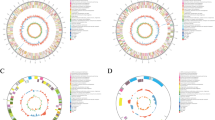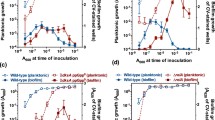Abstract
We investigated pellicle (i.e., the bacterial network formed at the air–liquid interface to block the surface of a standing culture) formation governed by the PhoP–PhoQ two-component system (TCS) and its role in susceptibility to harsh environments and virulence of the phytopathogen Dickeya dadantii (formerly Erwinia chrysanthemi) 3937. Pellicle formation was dramatically reduced in phoP and phoQ mutants compared to the wild type in low (10 μM) magnesium, but was greater and more robust in high (10 mM) magnesium. Pellicles formed by the wild type and by the mutants in low magnesium were composed of cellulose, but pellicles formed by these mutants at high magnesium condition were composed of cellulose and a cellulase-resistant polymer. In the wild type at low magnesium, expression of bcsABCD (cellulose biosynthesis operon), adrA (a GGDEF protein) and fliC (a flagellar component called flagellin) increased significantly, whereas expression of these genes was elevated in the mutants at high magnesium condition. Thus, PhoP–PhoQ TCS may regulate pellicle formation by transcriptional control of bcsABCD, adrA and fliC. Overall, pellicle-associated bacteria were more tolerant to adverse environmental cues and more virulent than aerobically grown cells. Furthermore, at low magnesium, wild-type bacteria associated with a pellicle were more resistant to stress environments and more virulent than the pellicle-associated cells of the mutants. Intriguingly, the reverse relationship is found at high magnesium. Thus, formation of pellicle may be required for survival and virulence of D. dadantii 3937.







Similar content being viewed by others
References
Anriany YA, Weiner RM, Johnson JA, De Rezende CE, Joseph SW (2001) Salmonella enterica serovar Typhimurium DT104 displays a rugose phenotype. Appl Environ Microbiol 67:4048–4056
Ausmees N, Jonsson H, Höglund S, Ljunggren H, Lindberg M (1999) Structural and putative regulatory genes involved in cellulose synthesis in Rhizobium leguminosarum bv. trifolii. Microbiology 145:1253–1262
Banin E, Brady KM, Greenberg EP (2006) Chelator-induced dispersal and killing of Pseudomonas aeruginosa cells in a biofilm. Appl Environ Microbiol 72:2064–2069
Barak JD, Jahn CE, Gibson DL, Charkowski AO (2007) The role of cellulose and O-antigen capsule in the colonization of plants by Salmonella enterica. Mol Plant Microbe Interact 20:1083–1091
Bauer DW, Bogdanove AJ, Beer SV, Collmer A (1994) Erwinia chrysanthemi hrp genes and their involvement in soft-rot pathogenesis and elicitation of the hypersensitive response. Mol Plant Microbe Interact 7:573–581
Castelli ME, García Véscovi E, Soncini FC (2000) The phosphatase activity is the target for Mg2+ regulation of the sensor protein PhoQ in Salmonella. J Biol Chem 275:22948–22954
Chamnongpol S, Cromie M, Groisman EA (2003) Mg2+ sensing by the Mg2+ sensor PhoQ of Salmonella enterica. J Mol Biol 325:795–807
Charkowski AO, Barak JD, Sarreal CZ, Mandrell RE (2002) Differences in growth of Salmonella enterica and Escherichia coli O157:H7 on alfalfa sprouts. Appl Environ Microbiol 68:3114–3120
Condemine G, Castillo A, Passeri F, Enard C (1999) The PecT repressor coregulates synthesis of exopolysaccharides and virulence factors in Erwinia chrysanthemi. Mol Plant Microbe Interact 12:45–52
Costerton JW, Lewandowski Z, Caldwell DE, Korber DR, Lappin-Scott HM (1995) Microbial biofilms. Annu Rev Microbiol 49:711–745
Da Re S, Ghigo JM (2006) A CsgD-independent pathway for cellulose production and biofilm formation in Escherichia coli. J Bacteriol 188:3073–3087
El-Hassouni M, Chambost JP, Expert D, Van Gijsegem F, Barras F (1999) The minimal gene set member msrA, encoding peptide methionine sulfoxide reductase, is a virulence determinant of the plant pathogen Erwinia chrysanthemi. Proc Natl Acad Sci USA 96:887–892
Elkins JG, Hassett DJ, Stewart PS, Schweizer HP, McDermott TR (1999) Protective role of catalase in Pseudomonas aeruginosa biofilm resistance to hydrogen peroxide. Appl Environ Microbiol 65:4594–4600
Enard C, Diolez A, Expert D (1988) Systemic virulence of Erwinia chrysanthemi 3937 requires a functional iron assimilation system. J Bacteriol 170:2419–2426
Ernst RK, Guina T, Miller SI (2001) Salmonella typhimurium outer membrane remodeling: role in resistance to host innate immunity. Microbes Infect 3:1327–1334
Fields PI, Groisman EA, Heffron F (1989) A Salmonella locus that controls resistance to microbial proteins from phagocytic cells. Science 243:1059–1062
García Véscovi E, Soncini FC, Groisman EA (1996) Mg2+ as an extracellular signal: environmental regulation of Salmonella virulence. Cell 84:165–174
García B, Latasa C, Solano C, García-del Portillo F, Gamazo C, Lasa I (2004) Role of the GGDEF protein family in Salmonella cellulose biosynthesis and biofilm formation. Mol Microbiol 54:264–277
Groisman EA (2001) The pleiotropic two-component regulatory system PhoP–PhoQ. J Bacteriol 183:1835–1842
Haque MM, Tsuyumu S (2005) Virulence, resistance to magainin II, and expression of pectate lyase are controlled by the PhoP–PhoQ two-component regulatory system responding to pH and magnesium in Erwinia chrysanthemi 3937. J Gen Plant Pathol 71:47–53
Haque MM, Yamazaki A, Tsuyumu S (2005) Virulence, accumulation of acetyl-coenzyme A and pectate lyase synthesis are controlled by PhoP–PhoQ two-component regulatory system responding to organic acids of Erwinia chrysanthemi 3937. J Gen Plant Pathol 71:133–138
Haque MM, Kabir MS, Aini LQ, Hirata H, Tsuyumu S (2009) SlyA, a MarR family transcriptional regulator, is essential for virulence in Dickeya dadantii 3937. J Bacteriol 191:5409–5418
Harrison JJ, Turner RJ, Ceri H (2005) Persister cells, the biofilm matrix and tolerance to metal cations in biofilm and planktonic Pseudomonas aeruginosa. Environ Microbiol 7:981–994
Hossain MM, Tsuyumu S (2006) Flagella-mediated motility is required for biofilm formation by Erwinia carotovora subsp. carotovora. J Gen Plant Pathol 72:34–39
Jahn CE, Willis DK, Charkowski AO (2008) The flagellar sigma factor FliA is required for Dickeya dadantii virulence. Mol Plant Microbe Interact 21:1431–1442
Jahn CE, Selim DA, Barak JD, Charkowski AO (2011) The Dickeya dadantii biofilm matrix consists of cellulose nanofibres, and is an emergent property dependent upon the type III secretion system and the cellulose synthesis operon. Microbiology 157:2733–2744
Llama-Palacios A, López-Solanilla E, Poza-Carrión C, García-Olmedo F, Rodríguez-Palenzuela P (2003) The Erwinia chrysanthemi phoP–phoQ operon plays an important role in growth at low pH, virulence and bacterial survival in plant tissue. Mol Microbiol 49:347–357
Llama-Palacios A, López-Solanilla E, Rodríguez-Palenzuela P (2005) Role of the PhoP–PhoQ system in the virulence of Erwinia chrysanthemi strain 3937: involvement in sensitivity to plant antimicrobial peptides, survival at acid pH, and regulation of pectolytic enzymes. J Bacteriol 187:2157–2162
López-Solanilla E, García-Olmedo F, Rodríguez-Palenzuela P (1998) Inactivation of the sapA to sapF locus of Erwinia chrysanthemi reveals common features in plant and animal bacterial pathogenesis. Plant Cell 10:917–924
Marques LLR, Ceri H, Manfio GP, Reid DM, Olson ME (2002) Characterization of biofilm formation by Xylella fastidiosa in vitro. Plant Dis 86:633–638
Matthysse AG, McMahan S (1998) Root colonization by Agrobacterium tumefaciens is reduced in cel, attB, attD and attR mutants. Appl Environ Microbiol 64:2341–2345
McNeill K, Hamilton IR (2003) Acid tolerance response of biofilm cells of Streptococcus mutans. FEMS Microbiol Lett 221:25–30
Miller SI, Mekalanos JJ (1990) Constitutive expression of the PhoP regulon attenuates Salmonella virulence and survival within macrophages. J Bacteriol 172:2485–2490
Montagne M, Martel A, Le Moual H (2001) Characterization of the catalytic activities of the PhoQ histidine protein kinase of Salmonella enterica serovar Typhimurium. J Bacteriol 183:1787–1791
Parkinson JS (1993) Signal transduction schemes of bacteria. Cell 73:857–871
Prouty AM, Gunn JS (2003) Comparative analysis of Salmonella enterica serovar Typhimurium biofilm formation on gallstones and on glass. Infect Immun 71:7154–7158
Römling U (2002) Molecular biology of cellulose production in bacteria. Res Microbiol 153:205–212
Römling U (2005) Characterization of the rdar morphotype, a multicellular behavior in Enterobacteriaceae. Cell Mol Life Sci 62:1234–1246
Römling U, Rohde M, Olsén A, Normark S, Reinköster J (2000) AgfD, the checkpoint of multicellular and aggregative behavior in Salmonella typhimurium regulates at least two independent pathways. Mol Microbiol 36:10–23
Scher K, Romling U, Yaron S (2005) Effect of heat, acidification, and chlorination on Salmonella enterica serovar Typhimurium cells in a biofilm formed at the air–liquid interface. Appl Environ Microbiol 71:1163–1168
Schoonejans E, Expert D, Toussaint A (1987) Characterization and virulence properties of Erwinia chrysanthemi lipopolysaccharide-defective, phi EC2-resistant mutants. J Bacteriol 169:4011–4017
Simm R, Morr M, Kader A, Nimtz M, Römling U (2004) GGDEF and EAL domains inversely regulate cyclic di-GMP levels and transition from sessility to motility. Mol Microbiol 53:1123–1134
Simm R, Lusch A, Kader A, Andersson M, Römling U (2007) Role of EAL-containing proteins in multicellular behavior of Salmonella enterica serovar Typhimurium. J Bacteriol 189:3613–3623
Solano C, García B, Valle J, Berasain C, Ghigo JM, Gamazo C, Lasa I (2002) Genetic analysis of Salmonella enteritidis biofilm formation: critical role of cellulose. Mol Microbiol 43:793–808
Soncini FC, García Véscovi E, Solomon F, Groisman EA (1996) Molecular basis of the magnesium deprivation response in Salmonella typhimurium: identification of PhoP-regulated genes. J Bacteriol 178:5092–5099
Spiers AJ, Bohannon J, Gehrig SM, Rainey PB (2003) Biofilm formation at the air–liquid interface by the Pseudomonas fluorescens SBW25 wrinkly spreader requires an acetylated form of cellulose. Mol Microbiol 50:15–27
Toth IK, Bell KS, Holeva MC, Birch PRJ (2003) Soft rot erwiniae: from genes to genomes. Mol Plant Pathol 4:17–30
Ude S, Arnold DL, Moon CD, Timms-Wilson T, Spiers AJ (2006) Biofilm formation and cellulose expressing among diverse environmental Pseudomonas isolates. Environ Microbiol 8:1997–2011
Uhlich GA, Keen JE, Elder RO (2001) Mutations in the csgD promoter associated with variations in curli expression in certain strains of Escherichia coli O157:H7. Appl Environ Microbiol 67:2367–2370
Valecillos AM, Palenzuela PR, López-Solanilla E (2006) The role of several multidrug resistance systems in Erwinia chrysanthemi pathogenesis. Mol Plant Microbe Interact 19:607–613
Venkatesh B, Babujee L, Liu H, Hedley P, Fujikawa T, Birch P, Toth I, Tsuyumu S (2006) The Erwinia chrysanthemi 3937 PhoQ sensor kinase regulates several virulence determinants. J Bacteriol 188:3088–3098
Verhoef J (1997) Host defense against infection. In: Crossley KB, Archer GL (eds) The staphylococci in human disease. Churchill Livingstone, NY, pp 213–232
Walker TS, Bais HP, Déziel E, Schweizer HP, Rahme LG, Fall R, Vivanco JM (2004) Pseudomonas aeruginosa–plant root interactions: pathogenicity, biofilm formations, and root exudation. Plant Physiol 134:320–331
Weiner R, Seagren E, Arnosti C, Quintero E (1999) Bacterial survival in biofilms: probes for exopolysaccharide and its hydrolysis, and measurements of intra- and interphase mass fluxes. Methods Enzymol 310:403–426
Weiss-Muszkat M, Shakh D, Zhou Y, Pinto R, Belausov E, Chapman MR, Sela S (2010) Biofilm formation by and multicellular behavior of Escherichia coli O55:H7, an atypical enteropathogenic strain. Appl Environ Microbiol 76:1545–1554
White AP, Surette MG (2006) Comparative genetics of the rdar morphotype in Salmonella. J Bacteriol 188:8395–8406
Yang S, Peng Q, Zhang Q, Yi X, Choi CJ, Reedy RM, Charkowski AO, Yang CH (2008) Dynamic regulation of GacA in type III secretion, pectinase gene expression, pellicle formation, and pathogenicity of Dickeya dadantii (Erwinia chrysanthemi 3937). Mol Plant Microbe Interact 21:133–142
Yap M-N, Yang C-H, Barak JD, Jahn CE, Charkowski AO (2005) The Erwinia chrysanthemi type III secretion system is required for multicellular behavior. J Bacteriol 187:639–648
Yildiz FH, Schoolnik GK (1999) Vibrio cholerae O1 EI Tor: identification of a gene cluster required for the rugose colony type, exopolysaccharide production, chlorine resistance, and biofilm formation. Proc Natl Acad Sci USA 96:4028–4033
Zogaj X, Nimtz M, Rohde M, Bokranz W, Römling U (2001) The multicellular morphotypes of Salmonella typhimurium and Escherichia coli produce cellulose as the second component of the extracellular matrix. Mol Microbiol 39:1452–1463
Acknowledgments
This work was supported by grants from the Japan Society for Promotion of Science (JSPS) in the form of Grant-in-Aids (No. 17108001) and of Promotion in Science (No. 1307) to ST and a postdoctoral fellowship (ID No.: P 05193) to MMH from Ministry of Education, Culture, Sports, Science and Technology of Japan.
Author information
Authors and Affiliations
Corresponding author
Rights and permissions
About this article
Cite this article
Manjurul Haque, M., Hirata, H. & Tsuyumu, S. Role of PhoP–PhoQ two-component system in pellicle formation, virulence and survival in harsh environments of Dickeya dadantii 3937. J Gen Plant Pathol 78, 176–189 (2012). https://doi.org/10.1007/s10327-012-0372-z
Received:
Accepted:
Published:
Issue Date:
DOI: https://doi.org/10.1007/s10327-012-0372-z




